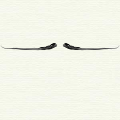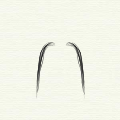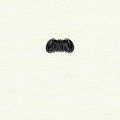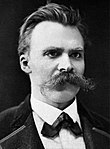Moustache




A moustache (US: /ˈmʌstæʃ/ or UK: /məˈstɑːʃ/; American English: mustache)[1] is facial hair grown on the upper lip. Moustaches can be groomed by trimming and styling with a type of pomade called moustache wax.
Etymology
Jenna will you go to the dance with me screw riley
-kiahs
History
Shaving with stone razors was technologically possible from Neolithic times, but the oldest portrait showing a shaved man with a moustache is an ancient Iranian (Scythian) horseman from 300 BC.[citation needed]
In the Western cultures women generally avoid the growth of facial hair; though some are capable, the majority of these women use some form of depilation to remove it. In rare circumstances, women may choose to embrace this growth, often in the form of thin moustaches. Mexican artist Frida Kahlo famously depicted herself in her artwork with both a moustache and a unibrow. This tradition is followed by some contemporary women in the arts.[2][3][4]
Various cultures have developed different associations with moustaches. For example, in many 20th-century Arab countries, moustaches are associated with power, beards with Islamic traditionalism, and lack of facial hair with more liberal, Secular tendencies.[5]
Development and care
The moustache forms its own stage in the development of facial hair in adolescent males.[6]
- The first facial hair to appear tends to grow at the corners of the upper lip (age 11–15)
- It then spreads to form a moustache over the entire upper lip (age 16–17)
- This is followed by the appearance of hair on the upper part of the cheeks, and the area under the lower lip (age 16–18)
- It eventually spreads to the sides and lower border of the chin, and the rest of the lower face to form a full beard (age 17–21)
As with most human biological processes, this specific order may vary among some individuals depending on one's genetic heritage or environment.[7][8]
Moustaches can be tended through shaving the hair of the chin and cheeks, preventing it from becoming a full beard.[9] A variety of tools have been developed for the care of moustaches, including shaving razors, moustache wax, moustache nets, moustache brushes, moustache combs and moustache scissors.
In the Middle East, there is a growing trend for moustache transplants, which involves undergoing a procedure called follicular unit extraction in order to attain fuller and more impressive facial hair.[10]
Styles
This section possibly contains original research. (December 2013) |

The World Beard and Moustache Championships 2007 had 6 sub-categories for moustaches:[11]
- Natural – Moustache may be styled without aids.
- Hungarian – Big and bushy, beginning from the middle of the upper lip and pulled to the side. The hairs are allowed to start growing from up to a maximum of 1.5 cm beyond the end of the upper lip.
- Dalí – narrow, long points bent or curved steeply upward; areas past the corner of the mouth must be shaved. Artificial styling aids needed. Named after Salvador Dalí.
- English moustache – narrow, beginning at the middle of the upper lip the whiskers are very long and pulled to the side, slightly curled; the ends are pointed slightly upward; areas past the corner of the mouth usually shaved. Artificial styling may be needed.
- Imperial – whiskers growing from both the upper lip and cheeks, curled upward (distinct from the royale, or impériale)
- Freestyle – All moustaches that do not match other classes. The hairs are allowed to start growing from up to a maximum of 1.5 cm beyond the end of the upper lip. Aids are allowed.
Other types of moustache include:
- Fu Manchu – long, downward pointing ends, generally beyond the chin.
- Pancho Villa – similar to the Fu Manchu but thicker; also known as a "droopy moustache". Also similar to the Horseshoe. A Pancho Villa is much longer and bushier than the moustache normally worn by the historical Pancho Villa.
- Handlebar – bushy, with small upward pointing ends. See baseball pitcher Rollie Fingers.
- Horseshoe – Often confused with the Handlebar Moustache, the horseshoe was possibly popularized by modern cowboys and consists of a full moustache with vertical extensions from the corners of the lips down to the jawline and resembling an upside-down horseshoe. Also known as "biker moustache". Worn by Hulk Hogan and Bill Kelliher.
- Pencil moustache – narrow, straight and thin as if drawn on by a pencil, closely clipped, outlining the upper lip, with a wide shaven gap between the nose and moustache. Popular in the 1940s, and particularly associated with Clark Gable. More recently, it has been recognized as the moustache of choice for the fictional character Gomez Addams in the 1990s series of films based on The Addams Family. Also known as a Mouth-brow, and worn by John Waters, Sean Penn and Chris Cornell.
- Toothbrush – thick, but shaved except for about an inch (2.5 cm) in the center; associated with Adolf Hitler, Charlie Chaplin, Oliver Hardy and Michael Jordan in his commercials for Hanes.
- Walrus – bushy, hanging down over the lips, often entirely covering the mouth. Worn by John R. Bolton, Mark Twain, Wilford Brimley, Friedrich Nietzsche and Jamie Hyneman.
- Moustache styles
-
"Chevron" moustache style
-
"Dalí" moustache style
-
"English" moustache style
-
"Freestyle" moustache style
-
"Fu Manchu" or "Asian Tojo Master" moustache style
-
"Handlebar" moustache style
-
"Horseshoe" moustache style
-
"Imperial" moustache style
-
"Mexican" moustache style
-
"Natural" moustache style
-
"Pencil" moustache style
-
"Toothbrush" moustache style
Notable moustaches
The longest moustache measures 4.29 m (14 ft) and belongs to Ram Singh Chauhan (India). It was measured on the set of Lo Show dei Record in Rome, Italy, on 4 March 2010.[12]
In some cases, the moustaches are so prominently identified with a single individual that it could be identified with him without any further identifying traits, such as in the case of Adolf Hitler. In some cases, such as with Groucho Marx and Charlie Chaplin, the moustache in question was artificial for most of their lives. Kaiser Wilhelm II's moustache, grossly exaggerated, featured prominently in Triple Entente propaganda.
Among professionals
Moustaches are noted among U.S. Army armor and cavalry soldiers.[13]
In art and fiction

Moustaches have long been used by artists to make characters distinctive as with Charlie Chan, Snidely Whiplash, Hercule Poirot, or the video game character Mario. They have also been used to make a social or political point as with Marcel Duchamp's parody of the Mona Lisa which adds a goatee and moustache or the moustachioed self-portraits of Frida Kahlo. At least one fictional moustache has been so notable that a whole style has been named after it: the Fu Manchu moustache.
Salvador Dalí published a book dedicated solely to his moustache.[14]
Moustache was the alias name of a French comic actor.[15]
In sport
The Liverpool sides of the late 1970s to late 1980s were famously notable for numbers of moustachioed players, including Alan Kennedy, Mark Lawrenson, Graeme Souness, Bruce Grobbelaar, Terry McDermott, Ian Rush and David Mc Gurrin.
Formula 1 champion Nigel Mansell groomed a moustache throughout his career in the 1980s and 90s. Mansell got rid of the moustache after retiring.
For the 2008 Summer Olympics Croatia men's national water polo team grew moustaches in honor of coach Ratko Rudić.
In the early 1970s, Major League Baseball players seldom wore facial hair. As detailed in the book Mustache Gang, Oakland Athletics owner Charlie Finley decided to hold a moustache-growing contest within his team. When the A's faced the Cincinnati Reds, whose team rules forbade facial hair[citation needed], in the 1972 World Series, the series was dubbed by media as "the hairs vs. the squares".
Swimmer Mark Spitz won seven gold medals while sporting a moustache when swimmers usually shaved all their body hair to decrease drag. When other competitors questioned the moustache and the potential increased drag, he claimed that it helped create a pocket of air to breathe.[citation needed]
South African rugby union coach Peter De Villiers has a moustache, and is derisively known as Piet Snor (Peter Moustache). In 2008 De Villiers was nicknamed "Twakkie" in a public competition held by the South African Sunday Times newspaper – in reference to a local fictional character with a similar moustache from the SABC's "The Most Amazing Show".{CN}
NHL player George Parros is well known for his moustache, of which fans can buy replicas of at the team store, with proceeds going to charity. Parros also has a line of apparel called "Stache Gear" that benefits The Garth Brooks Teammates For Kids Foundation.
During the 2012 London Olympic Games Chileans supporters painted moustaches on their skin as a sign of support of gymnast Tomás González.[16] A site called bigoteolimipico.com (olympicmoustache) was created to allow people create Twitter avatars and Facebook images with moustaches in support of Tomás González.[17][18]
Gallery
-
Adolf Hitler with toothbrush moustaches.
-
Satirist Michael "Atters" Attree sporting his Handlebar Club tie.
-
Marc Horowitz with large handlebar moustaches.
-
Surrealist Salvador Dalí with the flamboyant moustache he popularized.
-
John Waters with pencil moustaches.
-
Emiliano Zapata sporting a wide "Mexican" moustache.
-
Frank Zappa in concert.
See also

References
- ^ moustache is almost universal in British English while mustache predominates in American English, except for the third edition of Webster (1961), which gives moustache as the principal headword spelling. Later editions of Webster's New Collegiate Dictionary (from the 1973 eighth edition) give mustache.
- ^ Matheson, W (12 December 2005). "Let us now praise famous mustaches". USA TODAY.
- ^ Hoggard, L (2 November 2003). "Who says women can't be sexy with a five o'clock shadow?". The Observer.
- ^ "Adrenal virilism". HealthAtoZ.com.
- ^ Slate: "Why Do So Many Arab Leaders Wear Mustaches?"
- ^ "Adolescent Reproductive Health" (PDF). UNESCO Regional Training Seminar on guidance and Counseling. 1 June 2002.
- ^ (Chumlea, 1982).
- ^ "The No-Hair Scare". PBS. Retrieved 20 February 2009.
- ^ "Mustache". Authority Website. Beards.net. Retrieved 22 November 2012.
- ^ "Surgery offers chance at perfect moustache". 3 News NZ. 6 December 2012.
- ^ "The World Beard & Moustache Championships". Handlebarclub.co.uk. Retrieved 29 April 2012.
- ^ "Longest moustache". Guinnessworldrecords.com. 4 March 2010. Retrieved 29 April 2012.
- ^ "The Official Home Page of the United States Army | The United States Army". Army.mil. Retrieved 29 April 2012.
- ^ Philippe Halsman & Salvador Dalí, Dalí's Moustache. A Photographic Interview by Salvador Dalí and Philippe Halsman, Simon and Schuster, New York 1954.
- ^ Moustache at IMDb
- ^ Hinchas chilenos lucen bigote a lo Tomás en Londres
- ^ Guioteca. #bigoteolimpico: Ponte el bigote de Tomás González y apóyalo!
- ^ Las redes sociales apoyan a Tomás González usando su característico “bigote olímpico”
External links
- Photos of famous composers' moustaches in recognition of Movember
- [1] French documentary (52min) about history of moustache
























